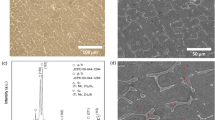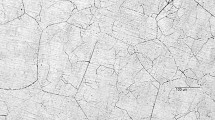Abstract
Ti–Zr alloys are expected to be novel biomaterials with low stress shielding owing to their lower Young’s moduli than pure Ti. The drawback of metallic biomaterials is that their bone-bonding abilities are relatively low. NaOH and heat treatments have been performed to provide Ti–50Zr with apatite-forming ability in the body environment, which is essential for bone bonding. However, the systematic compositional dependence of apatite formation has not been revealed. In the present study, NaOH treatment of Ti–Zr alloys with various compositions and bone-bonding abilities was assessed in vitro by apatite formation in simulated body fluid (SBF). The corrosion current density in NaOH aqueous solution and the amount of Na incorporated into the surface tended to decrease with increasing Zr content. The apatite-forming ability of the treated alloy significantly decreased when the Zr content was ≥60 atom%. This phenomenon is attributed to the (1) low OH content on the surface, (2) low Na incorporation into the treated alloy surface, which enhances apatite formation, and (3) low ability of P adsorption to the Ti–Zr alloy in SBF following Ca adsorption to trigger apatite nucleation. Although the adhesion of the titanate/zirconate layer formed on the surfaces to the substrates increased as Zr content increased, the adhesion between the apatite and the substrate was still low.











Similar content being viewed by others
References
Breme J, Biehl V. Metallic biomaterials. In: Black J, Hastings G, eds. Handbook of biomaterial properties. London: Chapman & Hall; 1998. pp. 135–213.
Yan WQ, Nakamura T, Kobayashi M, Kim HM, Miyaji F, Kokubo T. Bonding of chemically treated titanium implants to bone. J Biomed Mater Res. 1997;37:267–75.
Kokubo T, Kim HM, Kawashita M. Novel bioactive materials with different mechanical properties. Biomaterials. 2003;24:2161–75.
Cho SB, Kokubo T, Nakanishi K, Soga N, Ohtsuki C, Nakamura T, et al. Dependence of apatite formation on silica gel on its structure: effect of heat treatment. J Am Ceram Soc. 1995;78:1769–74.
Kim HM, Miyaji F, Kokubo T, Nakamura T. Preparation of bioactive Ti and its alloys via simple chemical surface treatment. J Biomed Mater Res. 1996;32:409–17.
Wang XX, Hayakawa S, Tsuru K, Osaka A. A comparative study of in vitro apatite deposition on heat-, H2O2-, and NaOH-treated titanium surfaces. J Biomed Mater Res. 2001;54:172–8.
Yang BC, Uchida M, Kim HM, Zhang Z, Kokubo T. Preparation of bioactive titanium metal via anodic oxidation treatment. Biomaterials. 2004;25:1003–10.
Nakagawa M, Zhang L, Udoh K, Matsuya S, Ishikawa K. Effects of hydrothermal treatment with CaCl2 solution on surface property and cell response of titanium implants. J Mater Sci Mater Med. 2005;16:985–91.
Kawashita M, Matsui N, Miyazaki T, Kanetaka H. Effect of autoclave and hot water treatments on surface structure and in vitro apatite-forming ability of NaOH- and heat-treated bioactive titanium metal. Mater Trans. 2013;54:811–6.
Niinomi M. Recent research and development in titanium alloys for biomedical applications and healthcare goods. Sci Tech. Adv Mater. 2003;4:445–54.
Ho WF, Chen WK, Wu SC, Hsu HC. Structure, mechanical properties, and grindability of dental Ti-Zr alloys. J Mater Sci Mater Med. 2008;19:3179–86.
Hari Kumar KC, Wollants P, Delacy L. Thermodynamic assessment of the Ti-Zr system and calculation of the Nb-Ti-Zr phase diagram. J Alloy Compd. 1994;206:121–7.
Shiraishi T, Yubuta K, Shishido T, Shinozaki N. Elastic properties of as-solidified Ti-Zr binary alloys for biomedical applications. Mater Trans. 2016;57:1986–92.
Uchida M, Kim HM, Miyaji F, Kokubo T, Nakamura T. Apatite formation on zirconium metal treated with aqueous NaOH. Biomaterials. 2002;23:313–7.
Chen X, Nouri A, Lin YJ, Hodgson PD, Wen C. Effect of surface roughness of Ti, Zr, and TiZr on apatite precipitation from simulated body fluid. Biotech Bioeng. 2008;101:378–87.
Chen X, Li Y, Hodgson PD, Wen C. In vitro behavior of human osteoblast-like cells (SaOS2) cultured on surface modified titanium and titanium–zirconium alloy. Mater Sci Eng C. 2011;31:1545–52.
Miyazaki T, Sasaki T, Shirosaki Y, Yokoyama K, Kawashita M. Effect of metallographic structure and machining process on the apatite-forming ability of sodium hydroxide- and heat-treated titanium. Bio-Med Mater Eng. 2018;29:109–18.
Sakamoto H, Hirohashi Y, Saito H, Doi H, Tsutsumi Y, Suzuki Y, et al. Effect of active hydroxyl groups on the interfacial bond strength of titanium with segmented polyurethane through γ-mercapto propyl trimethoxysilane. Dent Mater J. 2008;27:81–92.
Pourbaix M. Atlas of electrochemical equilibria in aqueous solutions. Houston: National Association of Corrosion Engineers; 1974.
Motooka T, Yamamoto M. Corrosion behavior of Zr, Ti, Ta and Nb in sodium hydroxide solutions. Zairyo-to-Kankyo. 2011;60:394–401. (in Japanese)
Li P, Ohtsuki C, Kokubo T, Nakanishi K, Soga N, de Groot K. The role of hydrated silica, titania, and alumina in inducing apatite on implants. J Biomed Mater Res. 1994;28:7–15.
Uchida M, Kim HM, Kokubo T, Miyaji F, Nakamura T. Bonelike apatite formation induced on zirconia gel in a simulated body fluid and its modified solutions. J Am Ceram Soc. 2001;84:2041–44.
Kobayashi T, Sasaki T, Takagi I, Moriyama H. Solubility of zirconium (IV) hydrous oxides. J Nucl Sci Tech. 2007;44:90–94.
Hanawa T, Okuno O, Hamanaka H. Compositional change in surface of Ti-Zr alloys in artificial bioliquid. J Jpn Inst Metals Mater. 1992;56:1168–73. (in Japanese)
Tsutsumi Y, Nishimura D, Doi H, Nomura N, Hanawa T. Difference in surface reactions between titanium and zirconium in Hanks’ solution to elucidate mechanism of calcium phosphate formation on titanium using XPS and cathodic polarization. Mater Sci Eng C. 2009;29:1702–8.
Lin J, Zhan Y, Wang H, Chu M, Wang C, He Y, et al. Effect of calcium ion on phosphate adsorption onto hydrous zirconium oxide. Chem Eng J. 2017;309:118–29. https://doi.org/10.1016/j.cej.2016.10.001.
Takadama H, Kim HM, Kokubo T, Nakamura T. An X-ray photoelectron spectroscopy study of the process of apatite formation on bioactive titanium metal. J Biomed Mater Res. 2001;55:185–93.
Hashimoto M, Ogawa T, Kitaoka S, Muto S, Furuya M, Kanetaka H, et al. Control of surface potential and hydroxyapatite formation on TiO2 scales containing nitrogen-related defects. Acta Mater. 2018;155:379–85.
Miyazaki T, Sueoka M, Shirosaki Y, Shinozaki N, Shiraishi T. Development of hafnium metal and titanium-hafnium alloys having apatite-forming ability by chemical surface modification. J Biomed Mater Res Part B Appl Biomater. 2018;106B:2519–23.
Kim HM, Miyaji F, Kokubo T, Nakamura T. Effect of heat treatment on apatite-forming ability of Ti metal induced by alkali treatment. J Mater Sci Mater Med. 1997;8:341–7.
Acknowledgements
The authors thank Ms. Akiko Nomura and Mr. Kazuo Obara of the Institute for Materials Research, Tohoku University, Sendai, Japan for their assistance with sample alloy preparation. We thank Tim Cooper, Ph.D., from Edanz Group (www.edanzediting.com/ac) for editing a draft of this manuscript.
Author information
Authors and Affiliations
Corresponding author
Ethics declarations
Conflict of interest
The authors declare that they have no conflict of interest.
Additional information
Publisher’s note Springer Nature remains neutral with regard to jurisdictional claims in published maps and institutional affiliations.
Rights and permissions
About this article
Cite this article
Miyazaki, T., Hosokawa, T., Yokoyama, K. et al. Compositional dependence of the apatite formation ability of Ti–Zr alloys designed for hard tissue reconstruction. J Mater Sci: Mater Med 31, 110 (2020). https://doi.org/10.1007/s10856-020-06448-9
Received:
Accepted:
Published:
DOI: https://doi.org/10.1007/s10856-020-06448-9




